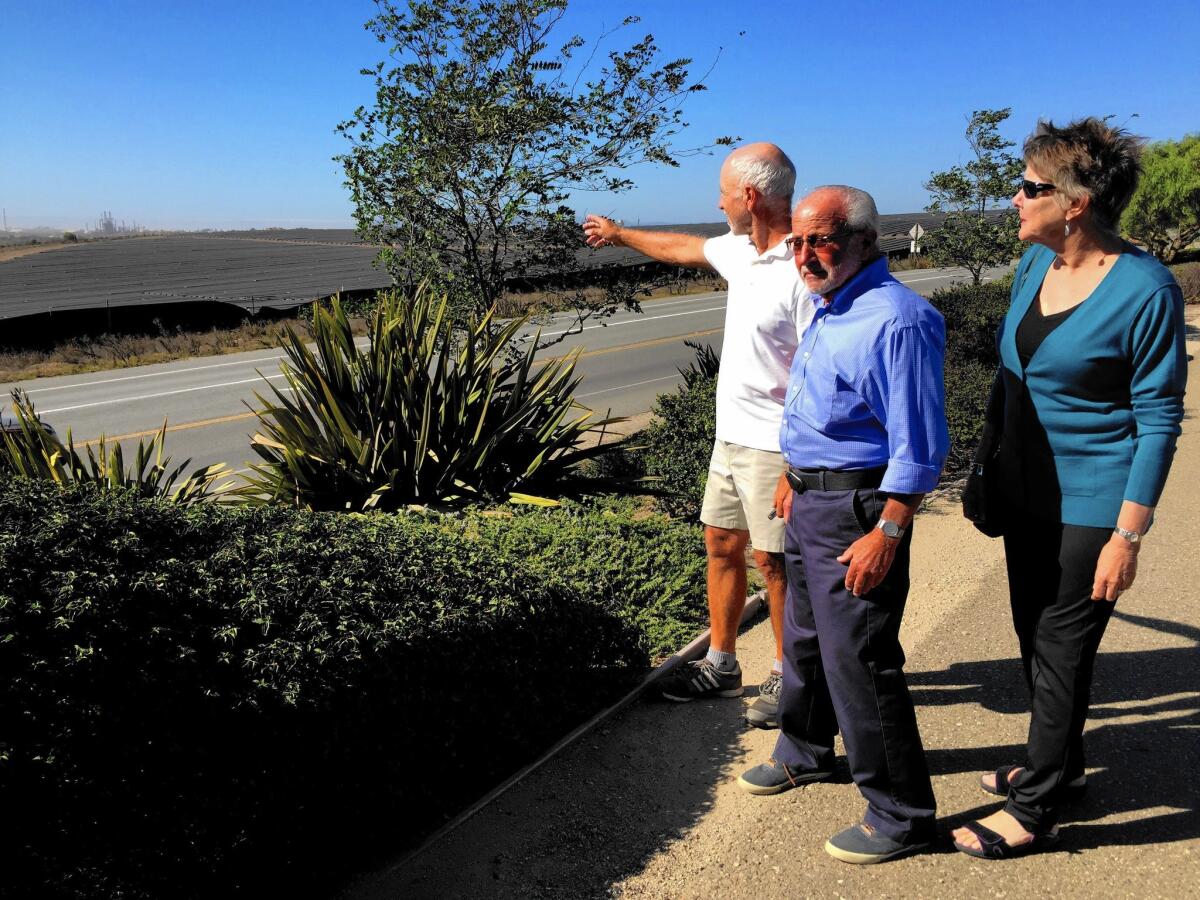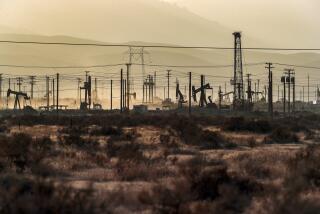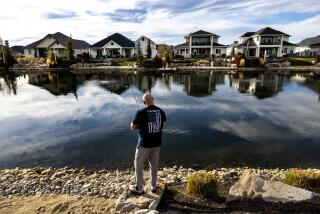To protect their homes, Nipomo retirees are taking on an oil refinery

It’s a well-trod path for many urban Californians: You hit retirement age, you start dreaming about living in the country, away from the noise, the traffic, the high cost of living.
You decamp from, say, your job as a real estate agent in Irvine, and settle into a new life on the Central Coast, in a house near the eucalyptus groves of the Nipomo Mesa.
You are aware, of course, that there’s a small oil refinery between your neighborhood and the ocean. You can see it below you, off in the distance across Highway 1, near the sand dunes. It’s not the most picturesque part of the vista, but what can you do?
The Phillips 66 Santa Maria Refinery has been there 60 years. Its crude oil arrives unseen, by pipeline. It employs more than 100 locals. It has been a good neighbor.
Linda Reynolds, who happens to be that former Irvine real estate agent, moved here in early 2013. She and her husband own a home in Trilogy at Monarch Dunes, an upscale golf course community that boasts a butterfly sanctuary on its premises.
“Loved Orange County, but we were looking for a quiet, country-type lifestyle,” Reynolds, 67, told me. “It’s a pretty area, a nice community. In the fall of 2013, we began to hear rumblings. Then we heard about the train.”
The train?
In December 2013, Reynolds attended a San Luis Obispo County Planning Commission meeting and learned that Phillips 66 had proposed building a rail terminal at the refinery to accommodate overland shipments of crude oil from as far as Canada and Texas. Trains would roll on Union Pacific tracks through the Central Valley or along the West Coast before arriving here.
The terminal would accommodate about 260 trains of crude oil a year — each train a mile long — carrying about 50,000 barrels of crude. Could you imagine what might happen if a crude oil train derailed and exploded in San Jose?
Reynolds and her neighbors could.
Suddenly, the refinery didn’t seem quite so benign.
::
California and its beloved oil-rich coastline have a long, intermittently catastrophic relationship with the fossil fuel industry.
The infamous Santa Barbara oil spill of 1969, which killed unknown numbers of birds, fish and mammals and lit a fire under a nascent environmental movement, was a rude awakening for many of us who came of age on the state’s pristine beaches in the 1960s and ‘70s.
As recently as five months ago, a corroded pipeline broke just north of Refugio State Beach in northern Santa Barbara County, spilling thousands of gallons of oil into a culvert that drained into the ocean.
In between those catastrophes, there was the horror story of Avila Beach, a once-funky outpost southwest of San Luis Obispo. The city’s whole downtown and beachfront had to be destroyed or excavated after it was discovered in 1989 that Unocal’s leaky pipelines, connected to a “tank farm” on the bluffs above the town, had created a toxic underground lake.
These were environmental disasters; no human lives were lost.
But a spill from a train is something else entirely. Most iterations of crude — whether Bakken crude or tar sands, which are mixed with a flammable liquid for transport — have explosive potential.
As my colleague Ralph Vartabedian found, the last three years have brought not just a significant increase in the number of oil-hauling trains because of the oil boom in places such as North Dakota, but a significant rise in the number of derailments. Most of the 31 crashes he studied were attributed to track failure, difficult to predict or detect.
The public was not even paying attention to this problem until July 2013, when an oil train derailed in Quebec’s Lac-Megantic. The ensuing conflagrations killed 47 people and reduced the town to ashes.
::
On Tuesday, I met with Reynolds and five of her neighbors in a plush common room at their subdivision. The six are founding members of the Mesa Refinery Watch Group. (Motto: “If the rail terminal is not built, the oil trains will not come.”)
I imagine these folks are kind of a nightmare for Phillips 66. Ranging in age from 61 to 73, they are highly educated professionals with backgrounds in science, engineering, economics, air pollution and hospital administration, and they are, mostly, retired.
Which means they have time.
Time for research. Time to make PowerPoint presentations. Time to lobby mayors and city councils and school boards all over San Luis Obispo County, and the rest of the state. Time to appear at club meetings. Time to write newsletters. Time to compile lists of oil train derailments. Time to comb through the 2012 Phillips 66 annual report that described how employing a new “crude-by-rail strategy” would bring cheaper (or “cost-advantaged”) oil to its refineries, boosting profits.
“We became concerned because we are within shouting distance of their proposed terminal,” said Martin Akel, 67, who owns a marketing consulting firm. “We saw a problem that affected health, safety and our very way of life.”
Normally, an oil refinery would not need local permission to bring in crude by rail. Rail freight is subject to federal, not local or state, regulation. Cities and counties don’t have a say, even though many in the state have officially opposed the project, including the city of Los Angeles.
But Phillips needs county permission to construct the tracks and oil storage tanks on its property. That is the only leverage available. A representative for Phillips told me the company remains committed to safety, and its rail expansion plans.
The San Luis Obispo Planning Commission is to take up the matter early next year. After that, the proposal goes to the county Board of Supervisors. No one knows how they will vote. But I’m putting my money on the retirees.
Twitter: @AbcarianLAT
More to Read
Start your day right
Sign up for Essential California for news, features and recommendations from the L.A. Times and beyond in your inbox six days a week.
You may occasionally receive promotional content from the Los Angeles Times.







